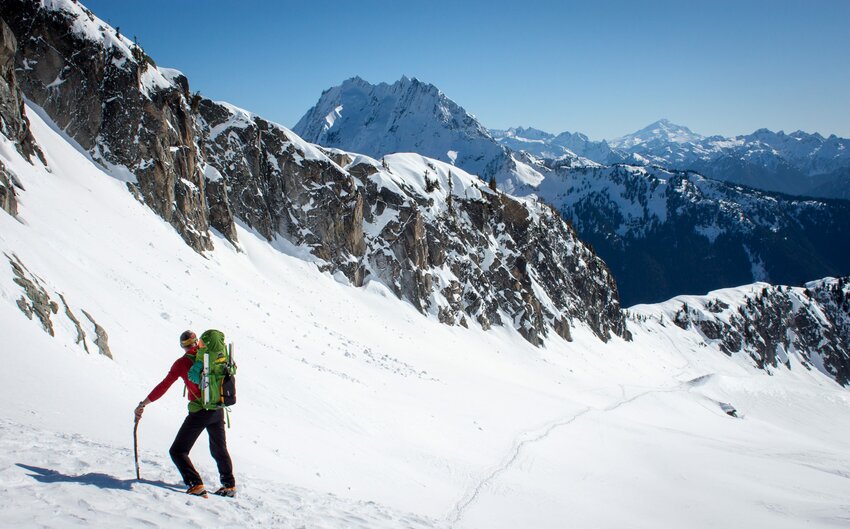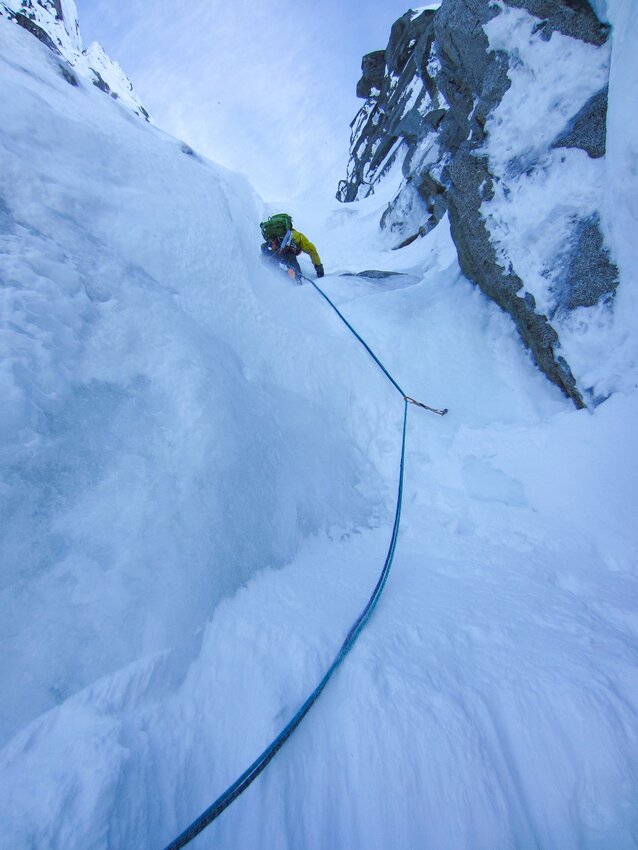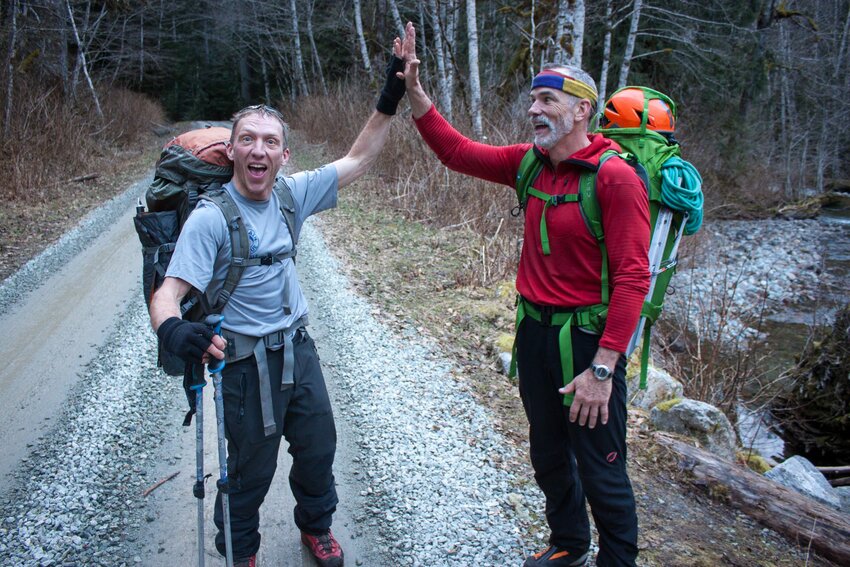 Chuck had never been up to Eldorado before and enjoyed the views.
Chuck had never been up to Eldorado before and enjoyed the views.The North Cascades are notoriously rugged. Even in summer, steep terrain combines with thick brush, unmaintained trails and changeable weather to challenge the strongest mountaineer. In winter, the range is even less kind. Wreathed in storms for weeks at a time, riven by avalanches that can break old growth trees like matchsticks, the heart of the North Cascades remains a mystery, especially those areas distant from highways 542 and 20.
This started to change when John Scurlock built his tiny yellow plane nearly 20 years ago and took to the skies over the North Cascades. He documented wild winter vistas that the rest of us could hardly believe were in our backyard. And so, a new generation of climbers was transfixed, transformed and mobilized to seek out the challenges that the range offers in winter.
I was one of those climbers, familiar with the North Cascades in summer, but mostly considering it off limits during the short days of midwinter. However, the combination of John’s images and the up-to-date information on the message board “CascadeClimbers.com” had a way of slowly drawing me in. Image after image, trip report after trip report, my fear began to wane until I found myself looking at the long-range forecast in February of 2015, wondering how the NW Couloir of Eldorado Peak was looking.
 Fantastic views on the way to the route.
Fantastic views on the way to the route.Wondering, that is the operative word. Snow and ice are fickle mediums. It is often hard to know exactly how a climb will be unless you take the gear for a walk and see for yourself. I was lucky that I had a few others in my circle that also didn’t mind going on long, potentially fruitless walks in the middle of winter. This included Chuck and Tim, former ultra-marathoners and keen climbers, who, like me, were eager to see the North Cascades in their winter glory.
Chuck and I left the Eldorado climber’s lot Saturday morning at a reasonable hour, beginning to trudge over a vertical mile up to the base of the East Ridge of the mountain. Tim maintained that he would meet us at high camp early on Sunday, but we carried enough gear that we could complete the climb if he didn’t make it in time. The “trail” up to Eldorado isn’t much of one, more a straight up boot beaten line that tells you where to go. Where it fades into a boulderfield, we punched through shallow snow, trying to keep from twisting a knee on our way to camp. In the North Cascades, often the crux of the trip takes place below treeline, and winter doesn’t make the lower elevations any easier.
Chuck had forgotten his ski poles, so he grabbed a sturdy stick in the forest and broke it off to length. As we climbed higher and stepped onto the glacier, the sight of him plodding along with his stick made me smile. Or maybe it was the views?
Across the valley, the grand sweep of the north face of Johannesburg was impossible to ignore, with her hanging glaciers and snow flutings looking to avalanche at any second. To the east, the graceful pyramid of Forbidden was even more beautiful than usual, its normally bare rocks almost completely plastered in a veneer of snow and ice.
But the light was fading fast, and we had to stamp out a platform for the tent, melt many liters of snow, and battle the rising wind and spindrift. This is the part of winter climbing/camping that I don’t relish. It is hard, cold work. Thankfully, as we tended to camp chores, our friends Jason and Krissy pleasantly surprised us. They were returning from a successful one-day ascent of the standard East Ridge of Eldorado. We chatted for a few minutes, but they couldn’t linger.
Chuck and I settled in for a long, wind blasted night at the base of the East Ridge, wondering if Tim would meet us the next morning. A bright moon lit the scene brightly. A headlamp wasn’t needed, but the cold wind chased us into our bags early. I slept fitfully, as I often do before uncertain climbs.
Would the snow be firm enough … the ice solid enough … the clear weather hold long enough … would we find the rappel anchors? So many questions we wouldn’t know answers to until we committed to the climb.
 The boys breaking down camp.
The boys breaking down camp.The day dawned clear, as forecasted, but high clouds were scudding across the sky from the west, heralding the next storm system. As we prepared breakfast we kept glancing south across the glacier, looking for Tim. We could only wait so long, and so we began to slowly stow our gear and put on our harnesses. We were pretty sure he wasn’t going to make it. And who could blame him? This was pretty ridiculous, and maybe even pointless. The NW Couloir wasn’t certain to be in good shape, but Chuck and I thought we could always go up Eldorado’s normal route as a consolation prize. Having a plan B is always a good idea in the North Cascades, even more so in the winter.
Then, just as we were turning to leave, a dot appeared far across the glacier, moving rapidly toward us. Tim was practically jogging and was soon at our camp, psyched for the day ahead despite the 2 a.m. start from his van. He grabbed one of our ropes and some of the pickets (snow stakes for protecting steep snow while climbing) and we set off across the glacier to find the rappel that would drop us near the base of the route. I grabbed a ski pole as we left camp, and Chuck grabbed his stick. Was he planning on packing it the whole way up and down the peak?
 Chuck on the first steep bit.
Chuck on the first steep bit.I didn’t have to wonder long, since the rappel anchor was less than a mile from camp. Tim and I quickly set up the rappel, threading both ropes through the anchor, and tossing them to the glacier 60 meters below. Chuck unceremoniously threw his stick to the side, threaded his belay device onto the ropes, and disappeared over the edge. I laughed, imagining climbers stumbling upon this stick next summer, so far from the forests below.
Once we touched down on the glacier, we had a view of the route, and it looked good. Consolidated snow and ice shone in the morning light just a short distance away. Our instincts had paid off. Quickly, I led out toward the couloir, roped to Chuck and Tim in case I punched through into a hidden crevasse. There were no tracks but ours, our senses fully awake to the possibilities, both good and bad.
At the base of the couloir, where it steepened, I stamped out a platform, sunk a picket into the icy snow and belayed Chuck and Tim up to me. Chuck grabbed the remaining pickets, ice screws, and draws and immediately started up. There is no time to waste in the winter and you must keep moving to stay warm. He soon began to encounter more challenging bits, primarily icy bulges over rock steps. As Chuck swung his ice tools, snow and ice chunks rained down, careening off the sides of the couloir. Tim and I huddled to the side as best we could, shifting right and left to dodge the biggest bits, and stamping our feet to stay warm.
This was repeated for several rope lengths as we worked our way up the couloir, Tim and Chuck taking turns to lead the team higher and higher in the cold shade of the gully while I trailed, taking photos. In all, we had found the climb in relatively “easy” conditions. This was just fine with us. We were in the heart of the range in the middle of winter, without another soul around. The jagged peaks around us held snow on their impossibly steep sides looking more like the greater ranges than the modest summits of our backyard. Above, as the climbing difficulties eased, we smiled and shook hands as we stowed gear for the final steps to the summit. It was rewarding to have snuck into the range on a whim and have it pay off so handsomely.
 Finished!
Finished!But the rising wind and the thickening clouds tempered our enthusiasm. We didn’t linger on the summit. We snapped a few photos and carefully descended back to camp to pack up and hustle down before the weather arrived. Tired, but satisfied, all three of us were lost in our thoughts as we trudged across the glacier in the late afternoon. The window we had used to sneak into the crystal fortress was about to slam shut. x
Jason Griffith is a fisheries biologist who would rather be on a summit than down by the river. When he isn’t fiddling with his camera in the mountains, he lives in Mount Vernon with his wife and two boys.